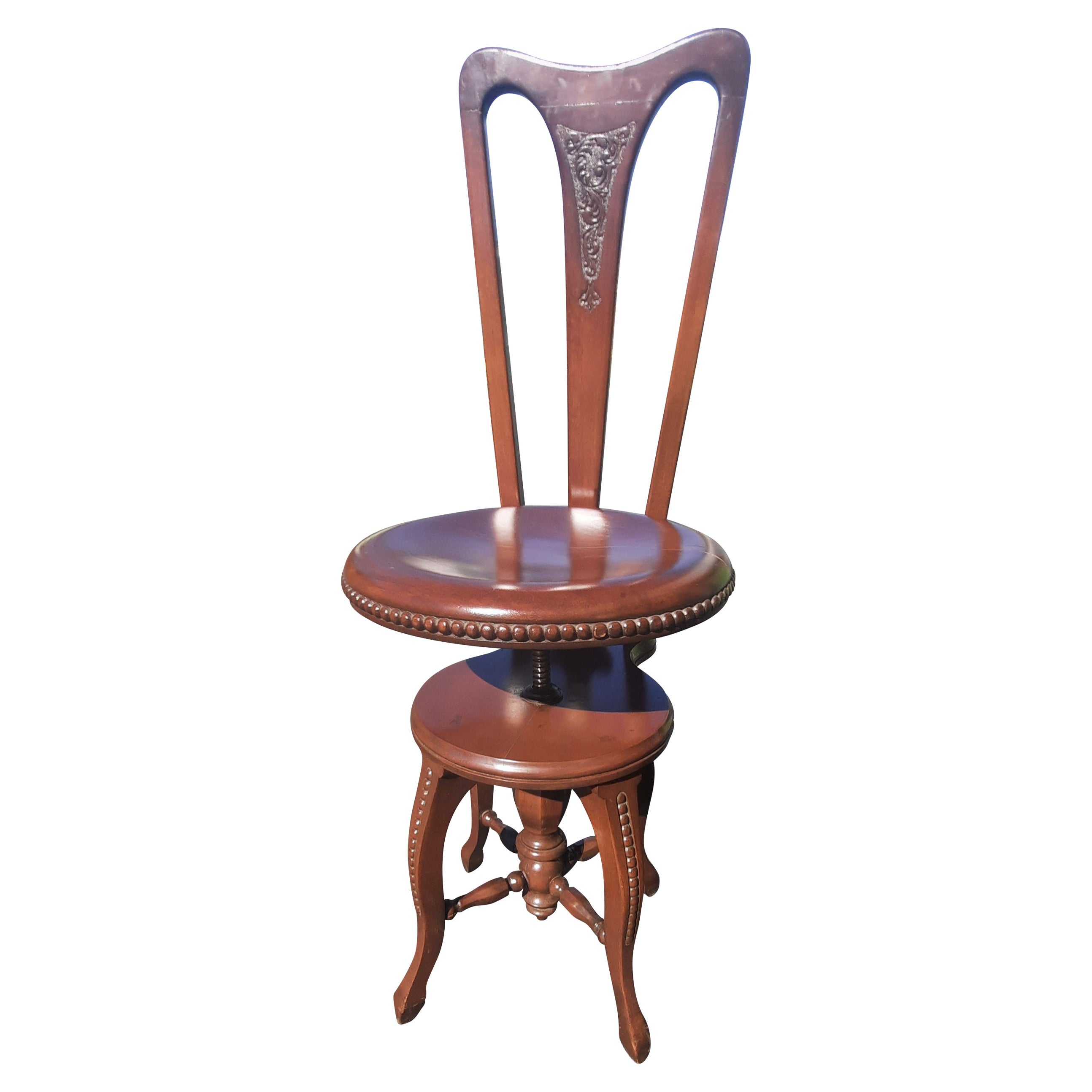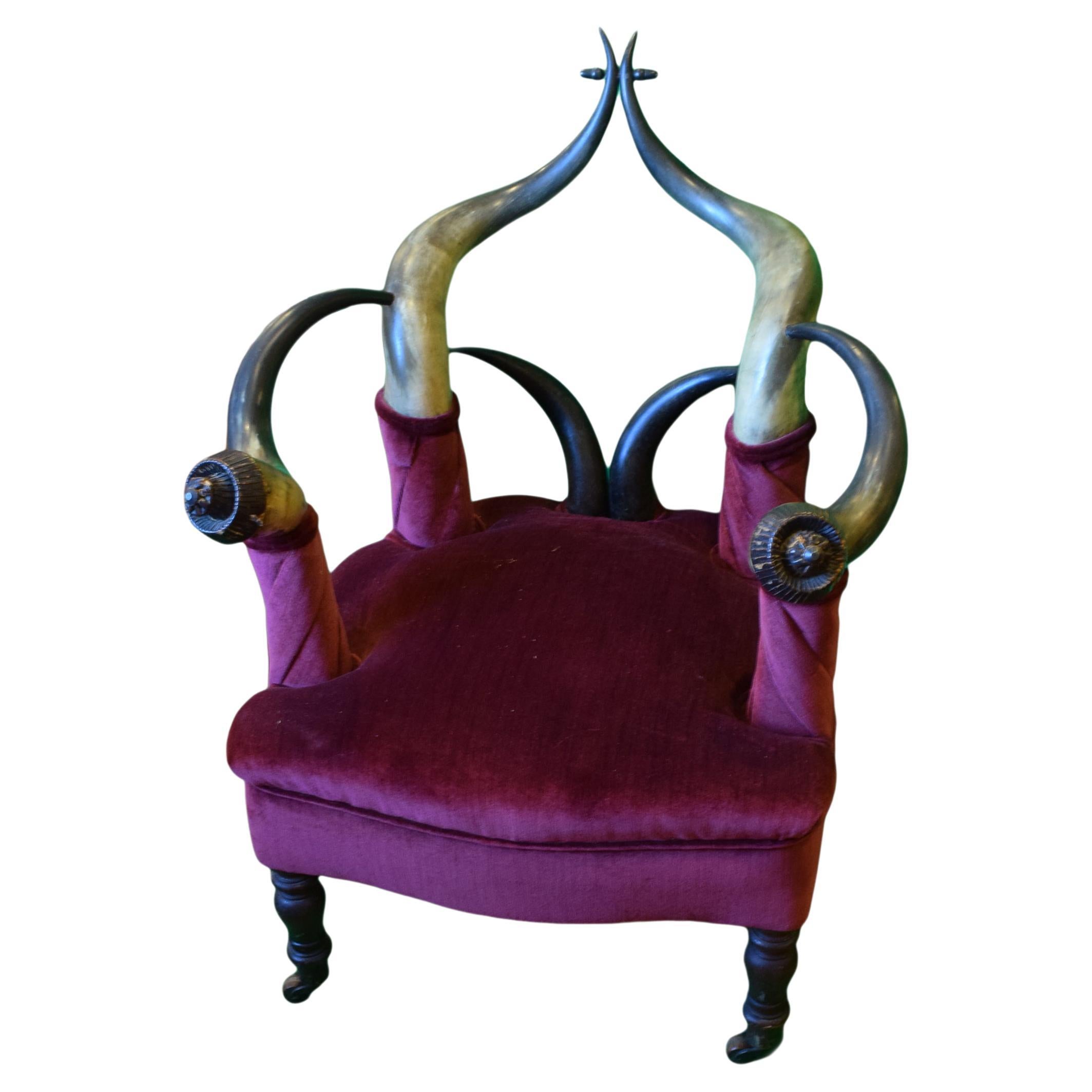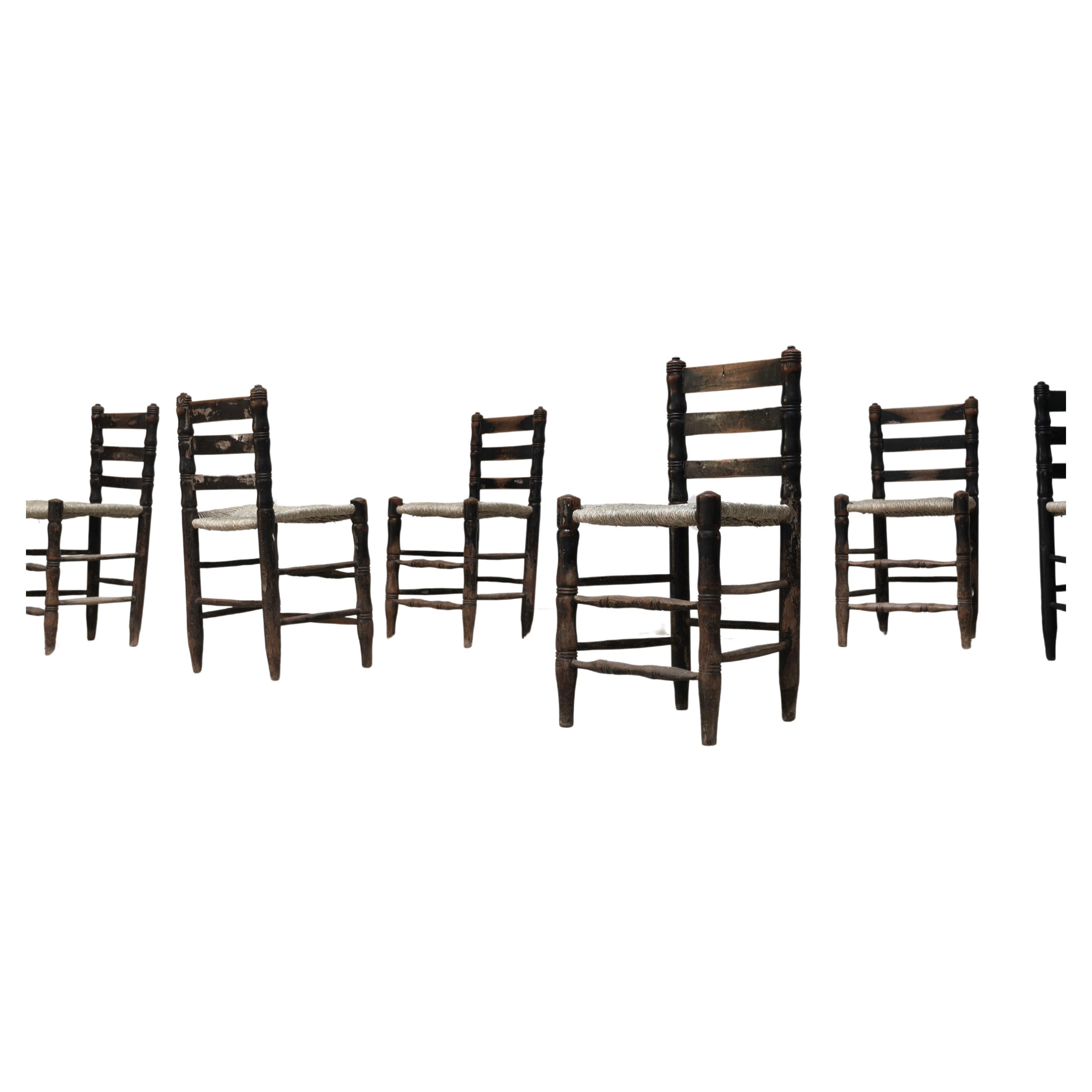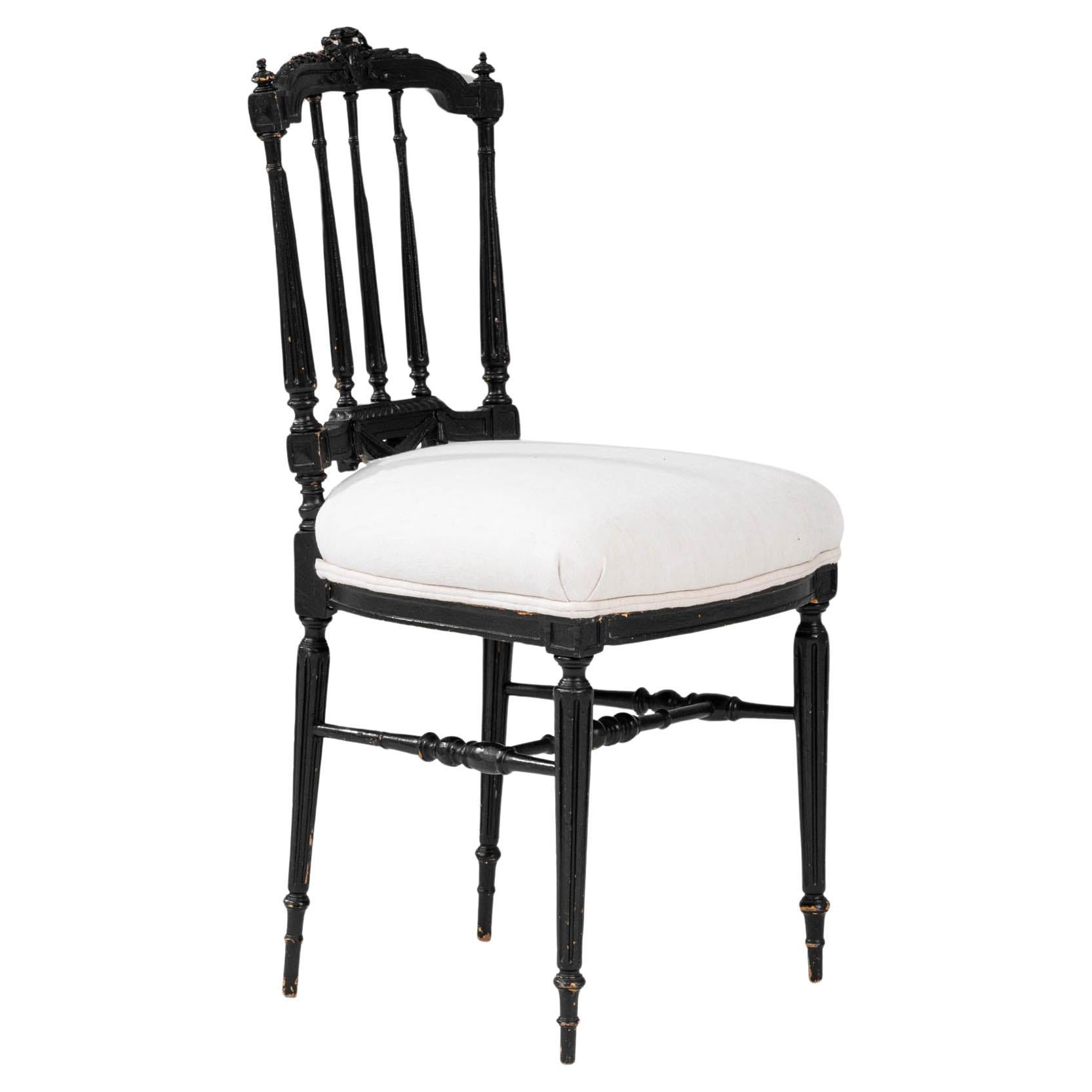Items Similar to 1880s German Piano Chair, Walnut, Height Adjustable
Video Loading
Want more images or videos?
Request additional images or videos from the seller
1 of 16
1880s German Piano Chair, Walnut, Height Adjustable
About the Item
Antique height adjustable piano chair
Germany
Walnut
Wilhelminian period around 1890
Dimensions: H x W x D: 105 x 46 x 45 cm, seat height variable from H 46 - 58 cm
Description:
Quite extraordinary and extremely rare to find in this form piano chair.
The baluster legs in front are an absolutely style-typical design feature of the Wilhelminian period. The construction is maximally stable by means of an H-bracing between the legs.
The rectangular backrest has an elaborate crown with scroll-like volutes.
A striking feature is the column centered above the footrests, which houses the height adjustment mechanism.
A small lever on the right side of the seat releases the locking mechanism. The seat can now be moved up and down and locked in ten height positions. Beautiful and so lovingly made are the scales on the left and right under the backrest, which can be used to read off the current position.
The mechanism is marked in a circle of the sun:
D.R. Patent No 45215. (D.R. - Deutsches Reich - German Empire).
A unique piece of furniture and an absolute enrichment for any living room with antique piano. Also useable as high adjustable children chair.
Condition:
Refurbished and ready for everyday use condition. The surface has been cleaned and oiled. The former wicker was upholstered over in a previous restoration. The upholstery fabric used at the time was replaced with a horsehair cover.
- Dimensions:Height: 41.34 in (105 cm)Width: 18.12 in (46 cm)Depth: 17.72 in (45 cm)Seat Height: 19.69 in (50 cm)
- Materials and Techniques:
- Place of Origin:
- Period:
- Date of Manufacture:1880-1890
- Condition:Refinished. Wear consistent with age and use. Refurbished and ready for everyday use condition.
- Seller Location:Greven, DE
- Reference Number:1stDibs: LU5419235875942
About the Seller
5.0
Platinum Seller
These expertly vetted sellers are 1stDibs' most experienced sellers and are rated highest by our customers.
Established in 2014
1stDibs seller since 2020
119 sales on 1stDibs
Typical response time: <1 hour
- ShippingRetrieving quote...Ships From: Münster, Germany
- Return PolicyA return for this item may be initiated within 14 days of delivery.
More From This SellerView All
- 1910s High Adjustable Duett Piano BenchLocated in Greven, DEAntique duet piano bench Germany Beech 1910s Dimensions: H x W x D: 65 x 100 x 36 cm, seat height adjustable from H 47 - 59 cm Description: Bench standing on tapered square legs t...Category
Early 20th Century German Art Nouveau Benches
MaterialsBeech
- Antique Silvered Deer Sculpture, France, 1880sLocated in Greven, DEBeautiful antique silvered bronze work on a black stone base. Finely chiseled and natuarally depicted. France, circa 1880.Category
Antique Late 19th Century French Late Victorian Paperweights
MaterialsBronze
- Antique Boule Ball "G", Pétanque, 1880s, France, CraftsmanshipLocated in Greven, DEBeautiful, unique Boule ball, France, late 19th Century. In the 19th century, the manufacture of boules balls underwent significant development in France as the game of boules, particularly the pétanque variant, gained in popularity. The manufacture of boules balls during this period was a manual process that required expertise, precision and love to detail. In the late 19th and early 20th centuries, particularly in rural areas of France and other Mediterranean regions, olive wood was a commonly used source of material for making boules balls. This was not only due to the availability of the material, but also to the outstanding properties of olive wood, which was characterized by hardness, strength and a rich grain. First, the olive wood was carefully selected and shaped into raw balls, which were then sanded to the desired size and shape. The nails were then hammered into the balls one by one, making sure that they were evenly distributed and firmly anchored. Finally, the spheres were polished and coated with a protective varnish to enhance their natural beauty and protect them from the elements. The use of nails to decorate and reinforce olive wood boules was a traditional practice that not only gave the ball a rustic aesthetic, but also improved its durability and contributed to customization. Many balls were made according to the specific requirements and preferences of the players. Nails were driven at regular intervals around the ball, with each nail hole precisely placed so as not to affect the balance and weight distribution of the ball. These nails not only served as a decorative element, but also helped to strengthen the structure of the ball and make it more resistant to the hard knocks and wear and tear during play. Individual engravings or decorations were often applied to the balls to make them unique and identify the player. Antique boules...Category
Antique Late 19th Century French Late Victorian Antiquities
MaterialsMetal
- Antique Boule Ball "7", Pétanque, 1880s, France, CraftsmanshipLocated in Greven, DEBeautiful, unique Boule ball, France, late 19th Century. In the 19th century, the manufacture of boules balls underwent significant development in France as the game of boules, particularly the pétanque variant, gained in popularity. The manufacture of boules balls during this period was a manual process that required expertise, precision and love to detail. In the late 19th and early 20th centuries, particularly in rural areas of France and other Mediterranean regions, olive wood was a commonly used source of material for making boules balls. This was not only due to the availability of the material, but also to the outstanding properties of olive wood, which was characterized by hardness, strength and a rich grain. First, the olive wood was carefully selected and shaped into raw balls, which were then sanded to the desired size and shape. The nails were then hammered into the balls one by one, making sure that they were evenly distributed and firmly anchored. Finally, the spheres were polished and coated with a protective varnish to enhance their natural beauty and protect them from the elements. The use of nails to decorate and reinforce olive wood boules was a traditional practice that not only gave the ball a rustic aesthetic, but also improved its durability and contributed to customization. Many balls were made according to the specific requirements and preferences of the players. Nails were driven at regular intervals around the ball, with each nail hole precisely placed so as not to affect the balance and weight distribution of the ball. These nails not only served as a decorative element, but also helped to strengthen the structure of the ball and make it more resistant to the hard knocks and wear and tear during play. Individual engravings or decorations were often applied to the balls to make them unique and identify the player. Antique boules...Category
Antique Late 19th Century French Late Victorian Antiquities
MaterialsMetal
- Antique Boule Ball "G", "J", Pétanque, 1880s, France, CraftsmanshipLocated in Greven, DEBeautiful, unique Boule ball, France, late 19th Century. Decorated with the initials "G" and "J". In the 19th century, the manufacture of boules balls underwent significant developm...Category
Antique Late 19th Century French Late Victorian Antiquities
MaterialsOlive
- Antique Bassinoire, Warming Pan, Copper, France, 1880sLocated in Greven, DEBeautiful copper pan from France, a so-called Bassinoire. The lid can be opened with an external lever. This antique form of a todays hot-water bottle was primarily used in aristocr...Category
Antique 19th Century French Antiquities
MaterialsCopper
You May Also Like
- Antique Carved Mahogany Adjustable Seat Height Piano Chair Music Room StoolLocated in Germantown, MDAn American music room chair with shaped crested rail, incised with scrolls. Ring turned supports, circular height adjustable seat, turned legs, x-stre...Category
Antique Late 19th Century Chairs
MaterialsMetal
- 1880s Texas Horn ChairLocated in Coeur d'Alene, IDThis horn chair came from Texas and was made for the Glantz Ranch between 1880 and 1900. The piece was inherited by Ruth Glantz around 1920 and purchased from her daughter by Fred an...Category
Antique 1880s American Chairs
MaterialsAntler, Leather, Horn
- 1880s French Wooden ChairLocated in High Point, NCStep into a bygone era of elegance and charm with our authentic 1880s French Wooden Chair. This exquisite piece of history is crafted with meticulous attention to detail, evident in ...Category
Antique Late 19th Century French Chairs
MaterialsWood
- Antique Victorian Walnut Upholstered Tufted Parlor Chair, Circa 1880sLocated in Germantown, MDAntique Victorian walnut Parlor chair, Circa 1880s. Exquisitely reupholstered and Tufted back with a luxurious fabric. Front fe...Category
Antique Late 19th Century American Victorian Side Chairs
MaterialsUpholstery, Walnut
- Spanish Antique rush chairs , 1880sLocated in Edogawa-ku Tokyo, JPSpanish Antique rush chairs , 1880s each price.Category
Antique 1880s Chairs
MaterialsWood
- 1880s French Wooden Chair With Upholstered SeatLocated in High Point, NCEmanating timeless elegance, this 1880s French wooden chair boasts an exquisite juxtaposition of the era's charm and a modern sensibility. The chair's high back is punctuated with sl...Category
Antique Late 19th Century French Chairs
MaterialsUpholstery, Wood





